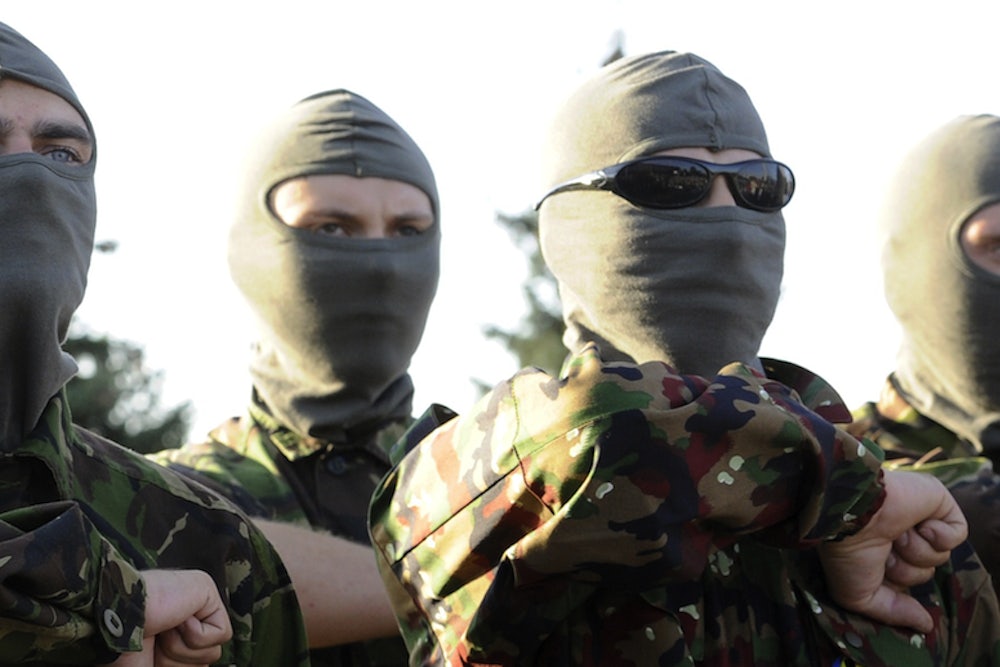Ukraine had given up on ceasefires. Each time the government imposed one, the fighting between Ukrainian forces and separatist rebels in the east continued. If anything, the ceasefires allowed the fractious rebel battalions time to regroup and refuel before the next battle.
But on Friday, after weeks of increased violence and significant losses for Ukrainian troops, representatives from the Ukrainian, Russian, and separatist governments, at a meeting in Minsk, all said they would agree to a ceasefire starting at 6 p.m. Rebel leaders Alexander Zakharchenko, Andrei Purgin, and Igor Plotnitsky, all in suits, sat across from Ukrainian and Russian diplomats, including former Ukrainian President Leonid Kuchma. And at approximately 6:10 p.m., BBC correspondents in the region said they received emails from separatist leaders inviting them to a press conference next Tuesday in Moscow, on why Ukrainian forces are breaking this ceasefire. Explosions were reportedly heard north of Donetsk minutes afterwards. If you’re wondering how seriously to take this ceasefire agreement, there’s your answer.
The ceasefire agreement includes fourteen conditions, including the peaceful exchange of hostages, an end to strikes on air force planes, and humanitarian corridors. But, as The New York Times reports, “The political outcome of the conflict was not included in the cease-fire proposals.” And therein lies the problem; the only political solution the rebel leaders will accept is autonomy, which Ukraine is resolutely unwilling to give.
On Thursday, separatist leaders said they would agree to a ceasefire on the condition that the Minsk summit would offer a suitable plan for a political solution to the conflict. Their willingness to abide by the ceasefire was announced in a “Statement from the Leaders of Novorossiya” posted to the official website of the self-proclaimed Donetsk People’s Republic (DNR), and confirmed on the organization’s official Twitter account Friday morning. But that same day, Interfax reports that DNR leaders claimed to have entered the critical port town of Mariupol, in southeastern Ukraine, where a new front in the conflict recently emerged. "This doesn't mean that our course for secession is over,” rebel leader Igor Plotnitsky told AP.
“The highest value is human life. We must do everything possible and impossible to terminate bloodshed and put an end to people's suffering,” Ukrainian Petro Poroshenko said in statement announcing the agreement on Friday. He made sure to emphasize that the ceasefire was propelled by the urging of EU and NATO leaders, whom he has been lobbying for help over the past couple days: “My international negotiations in Brussels and Minsk demonstrated a powerful request for peaceful political-diplomatic settlement of the conflict in the Donbas. The same mood dominated during my meetings with global leaders at the NATO Summit in Wales.” But none of those leaders are willing to help Ukraine fight back against Russian-supported rebels, a fight the devastated country cannot win on its own.
It's almost certain that this ceasefire will fall through; fractures between rebel groups mean that not all separatist fighters are receiving the same orders at once, and there is no evidence that Russia has stopped the flow of its armed forces into Ukraine. The border remains unsecured, and Russia's next humanitarian convoy is due to enter Ukraine on Saturday. The ceasefire negotiations have already lent a much-needed air of legitimacy to the separatist leadership, which will now be able to strengthen its calls for independence.
The result: Ukraine may very well turn into one of the Kremlin’s frozen conflicts, ensuring continued fighting and de-facto Russian control of the region. In the meantime, the people of Ukraine can only hope that this ceasefire means there will actually be a cessation of fire in eastern Ukraine.
